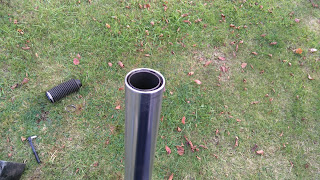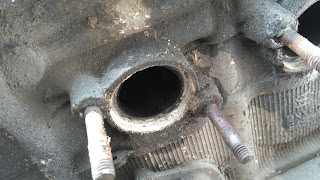So, time to take action!
The Showas that BMW chose to fit to the K75 are as basic as you can get. First loosen and remove the bolt that is at the bottom where the axle for the front wheel goes and let the oil out (you can try and pump the fork if you want).
Next up is to try and get the spring and spacer and damper rod and gubbins out from the inside of the fork. Normally this would be easy but it appears BMW have insisted on using the same snap-ring design as on the earlier Sachs forks. This means the top has to be depressed against the spring and the clip fished out. This stumped me for a while but I finally figured out the best way was to clamp the stanchion in the lower yoke and use the upper yoke to give somewhere to lever the top down with a screwdriver, like so:
Don't forget to remove the clip above the oil seal before you try and pull out the stanchion, I definitely didn't do that twice.. Anyway, the bad news here is that (as far as I know!) the original springs are progressive, meaning they won't work all that well with the valves.
The good news is that the top of the damper rods are the normal cup shape, meaning the valve/emulator/whatever will fit fine without an adapter.
So, that's the fork in bits. Now the fun starts! Look at these puny little holes..
Where's my professional-grade weapon of choice??
Now, for PD Valves of size 265 or bigger (these take 310) YSS recommend having 6 holes which are 8mm in diameter and there must be at least 10mm between the holes so that the damper rod can still hold up the bike without buckling/failing. As an aside the top of the damper rod for these forks is 25mm and here is the size chart, weirdly only supplied by YSS in the instructions in the kit (so once you've bought them) and not mentioned anywhere on their website that I can find..
They fit like this, if you didn't already know:
Anyway, where were we? Ah yes..
File and deburr the edges so that you don't send swarf all round the forks and the oil isn't sheared to buggery by sharp edges (I used a very small round file which took a long time)..
So, with that done we need some proper springs. Not only do we need some that are slightly shorter to compensate for the new extra tall damper rod/valve combo but we also need some that are linear. The springs out of these 41mm Showas are only 32mm outer diameter which is actually really small if you start looking at fork springs, however there was a ray of sunshine - Harley Davidson fitted 41mm Showas to their bikes too, and it turns out they fitted shorter linear springs. A quick search on ebay revealed a place called Huggy's Speed Shop had some Harley springs in stock with a completely unknown past, they merely arrived in a container full of bits. £30 exchanged hands and they were mine, muhahaha! Harley spring and spacer on the left, BMW spring and spacer on the right..
Racetech recommend 30mm spring preload when fitting their emulators to a Harley with these Showas which seemed to be about as much as was originally intended judging by the way the fork top pinged off. So, I fitted the Harley springs with the shorter BMW spacer and this little bit of magic happened at full extension:
Given the depth of the fork cap that is pretty much spot on. The springs are still completely unknown so I have no idea what their rate is but a Harley is a heavy bike and the K100 is a heavy bike so what can go wrong? Onwards with the reassembly! Put it all together and fit the bolt back in the bottom so it won't all fall apart.
The top bush was a right bugger to get back in..
Some very unprofessional tools and techniques were employed..
But eventually it went in. Don't give up!
Put the washer in..
Put your new oil seal in, which was the cause of all this to begin with (I've fitted TTO seals for the first time here because a pair of NOKs were coming in at about £25 which is totally unacceptable, these were £6.34 and TTO are still Japanese so should be alright at least for a bit - at least they're double lipped).
Sadly not the first time I've used a punch to install new seals but sometimes you have to work with what you've got. I now have a seal driver, I'm sure I'll have the opportunity to use it soon.. Anyway, install the wriggly clip on top of the oil seal and that particular bit of nastiness is all finished.
Use the same trick to squeeze the cap back in the top and install the horrible clip ring thing.
And there you nearly have it. Tighten the bolt at the bottom (I connected both forks together with the fork brace so the legs didn't twist round), probably with the old copper washers because it seems they're a special size and then fill the forks with oil. A quick test trying to bounce a fork on the lawn revealed the new springs to seem very firm so I went with 10w oil and only 350ml of it compared to the standard 410ml. After bolting the whole thing up and tightening the yoke clamps I took the bike off the stand and normally it would sag quite a bit under its own weight. Now it just kinda sits there. It sags a bit when I get on but I had to adjust the rear shock to max preload and I still feel like I'm riding uphill so the Harley springs are actually very hard indeed. The movement of the forks is improved though, and get better the faster you go which seems to be a hallmark of these valves - I suppose they do come from the world of racing after all.
So, there you have it - if you try this, let me know how you got on and what oil/springs/preload/valve preload you went with!































































































